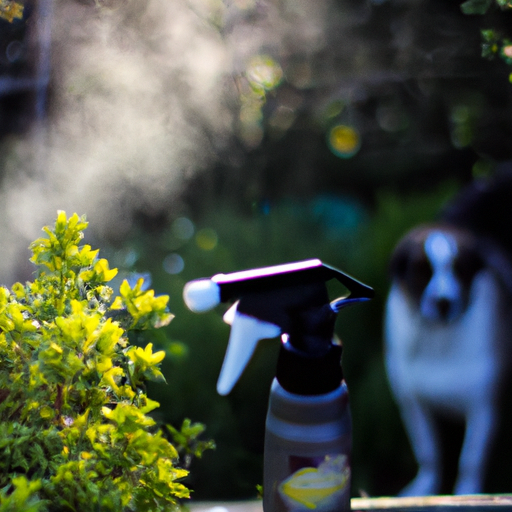As family members and loyal companions, dogs bring an incredible amount of joy and happiness into our lives. However, their curious nature and love for exploring can sometimes lead them into our gardens, causing some unwanted damage. If you’re struggling to keep your furry friend away from your plants, don’t worry. There are several safe and effective sprays you can use to deter them.
H2: Why Dogs Are Attracted to Plants
First, it’s important to understand why your dog might be attracted to your plants. Dogs are naturally inquisitive animals with a keen sense of smell. They are often drawn to the unique scents and textures of plants, which can lead to digging, chewing, and other destructive behaviors.
Several factors can contribute to your dog’s interest in plants:
- Boredom: Dogs left alone for long periods or without enough physical and mental stimulation may turn to plants for entertainment.
- Nutritional Needs: Some dogs may eat plants due to nutritional deficiencies or digestive issues.
- Hunting Instincts: The small insects and critters hiding in your plants can attract your dog’s attention.
Understanding these factors can help you find effective solutions and the best spray to keep your dog away from your plants.
H2: Natural Spray Solutions
There are several natural sprays that you can use to deter your dog from your plants. These sprays are made with ingredients that dogs find unpleasant but are harmless to both dogs and plants.
| Spray | Ingredients | How It Works |
|---|---|---|
| Citrus Spray | Lemon or orange peels, water | Dogs dislike the smell of citrus. |
| Vinegar Spray | White vinegar, water | The strong scent of vinegar is off-putting to dogs. |
| Spicy Spray | Cayenne pepper, water | Dogs are deterred by the strong smell and spicy taste. |
To make these sprays, simply combine the ingredients in a spray bottle and apply to the plants you want to protect. Remember to reapply regularly, especially after it rains.
H2: Commercial Spray Solutions
If you prefer a ready-made solution, there are several commercial sprays available on the market. These sprays are typically made with natural ingredients like bitter apple, mustard, and capsaicin, which dogs find unpleasant but are not harmful.
Some of the best-rated sprays include:
- Grannick’s Bitter Apple Spray: This spray uses a bitter flavor that dogs dislike. It’s safe for plants and can also be used on furniture and other items.
- Rocco & Roxie No Chew Extreme Bitter Spray: This strong, bitter spray is highly effective and safe for plants, furniture, and other surfaces.
- Bodhi Dog Bitter Lemon Spray: This spray combines the bitterness of lemons with a potent smell that dogs find unappealing.
H2: Training Your Dog to Stay Away From Plants
While sprays can be effective, they should be part of a larger strategy that includes training your dog to stay away from plants.
Here are some tips:
- Create a Dog-Friendly Zone: Designate a part of your yard where your dog can play and explore freely.
- Use Positive Reinforcement: Reward your dog for good behavior like leaving the plants alone.
- Provide Plenty of Exercise: A tired dog is a well-behaved dog. Make sure your dog gets plenty of physical and mental stimulation each day.
FAQ
Q: How often should I apply the spray?
A: Depending on the weather and your dog’s behavior, you may need to apply the spray every day or every few days.
Q: Will the spray harm my plants?
A: Most sprays are safe for plants. However, it’s always a good idea to test a small amount on a leaf first to ensure it won’t cause damage.
Q: Can I use these sprays on indoor plants?
A: Yes, these sprays can be used on both indoor and outdoor plants.
Q: What if the spray doesn’t work?
A: If the spray isn’t effective, consider seeking advice from a professional dog trainer or a vet. They may be able to provide additional strategies or identify underlying issues that might be causing your dog’s behavior.
Remember, the goal is to create a safe and harmonious environment for both your plants and your beloved pet. It might take some time and patience, but with the right approach, it’s entirely possible to achieve this balance.



